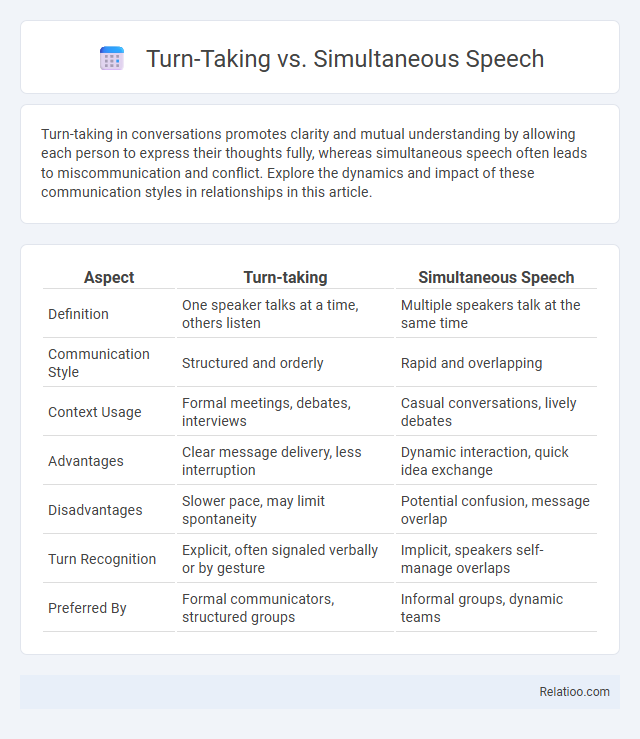Turn-taking in conversations promotes clarity and mutual understanding by allowing each person to express their thoughts fully, whereas simultaneous speech often leads to miscommunication and conflict. Explore the dynamics and impact of these communication styles in relationships in this article.
Table of Comparison
| Aspect | Turn-taking | Simultaneous Speech |
|---|---|---|
| Definition | One speaker talks at a time, others listen | Multiple speakers talk at the same time |
| Communication Style | Structured and orderly | Rapid and overlapping |
| Context Usage | Formal meetings, debates, interviews | Casual conversations, lively debates |
| Advantages | Clear message delivery, less interruption | Dynamic interaction, quick idea exchange |
| Disadvantages | Slower pace, may limit spontaneity | Potential confusion, message overlap |
| Turn Recognition | Explicit, often signaled verbally or by gesture | Implicit, speakers self-manage overlaps |
| Preferred By | Formal communicators, structured groups | Informal groups, dynamic teams |
Introduction to Conversational Dynamics
Turn-taking structures conversations by organizing speaker exchanges to prevent overlap and ensure clarity, enhancing Your understanding of interactive flow. Simultaneous speech, where multiple participants talk at once, often leads to misunderstandings and indicates high engagement or conflict. Analyzing turn-taking mechanisms reveals how conversational dynamics balance cooperation and competition in communication.
What is Turn-Taking in Communication?
Turn-taking in communication is the structured process where speakers alternate speaking roles to ensure clear and effective interaction. It prevents overlap and confusion by allowing one person to speak at a time, facilitating understanding and engagement. This contrasts with simultaneous speech, where participants talk over each other, often leading to misunderstandings and communication breakdowns.
Understanding Simultaneous Speech
Simultaneous speech occurs when multiple speakers talk at the same time, creating overlapping dialogue that can challenge clear communication and comprehension. Understanding simultaneous speech involves recognizing its role in fast-paced or emotionally charged conversations where speakers may unintentionally interrupt or speak over each other. Effective management of simultaneous speech enhances conversational flow by reducing confusion and improving listener engagement in turn-taking systems.
Key Differences Between Turn-Taking and Simultaneous Speech
Turn-taking involves speakers alternating their speech to ensure clear communication and avoid interruptions, while simultaneous speech occurs when multiple people talk at the same time, often leading to confusion. Your ability to recognize these patterns improves conversational flow and reduces misunderstandings. Key differences include the structure and timing of exchanges, with turn-taking promoting orderly dialogue and simultaneous speech risking overlapping messages.
Cultural Influences on Conversational Styles
Cultural influences play a significant role in shaping conversational styles such as turn-taking, simultaneous speech, and overlapping turns, with high-context cultures often favoring more fluid and simultaneous exchanges to convey meaning efficiently. In contrast, low-context cultures typically emphasize structured turn-taking to maintain clarity and avoid interruptions, reflecting differing communication norms and social expectations. Understanding these nuances enhances your ability to navigate cross-cultural interactions and fosters more effective communication across diverse cultural contexts.
Benefits of Turn-Taking in Dialogue
Turn-taking in dialogue enhances clarity and ensures that each participant's ideas are fully expressed, reducing misunderstandings and promoting effective communication. Your conversations benefit from structured exchanges where speakers listen actively and respond thoughtfully, fostering mutual respect and engagement. This method contrasts with simultaneous speech, which often leads to confusion and fragmented dialogue, making turn-taking essential for productive interactions.
Challenges of Simultaneous Speech
Challenges of simultaneous speech include overlapping dialogue that can cause confusion and reduce clarity in communication, making it difficult for listeners to process information accurately. Your ability to engage effectively is hindered when multiple speakers talk at once, leading to misinterpretation and decreased conversational flow. Managing turn-taking is essential to ensure messages are clearly conveyed and understood.
Effects on Communication Clarity and Understanding
Turn-taking in conversations enhances communication clarity by allowing speakers to express complete thoughts without overlap, reducing misunderstandings. Simultaneous speech often leads to confusion and breakdowns in comprehension due to competing auditory inputs. Effective turn-taking strategies improve mutual understanding and ensure that messages are conveyed clearly and accurately.
Technological Considerations for Voice Interfaces
Turn-taking in voice interfaces ensures clear command processing by managing when users speak, preventing overlap that can confuse speech recognition systems. Simultaneous speech challenges technology with overlapping audio, requiring advanced noise reduction and speaker diarization to separate voices accurately. Your voice assistant's responsiveness improves significantly when turn-taking mechanisms prioritize user input timing and context to maintain conversational flow and minimize errors.
Choosing the Right Approach for Effective Communication
Choosing the right communication approach impacts message clarity and engagement, where turn-taking allows structured dialogue and ensures each participant's views are heard without interruption. Simultaneous speech, common in dynamic environments, supports rapid information exchange but may cause misunderstandings if unmanaged. Your choice should align with context, prioritizing turn-taking for clarity in meetings and simultaneous speech for fast-paced brainstorming or informal chats.

Infographic: Turn-taking vs Simultaneous Speech
 relatioo.com
relatioo.com